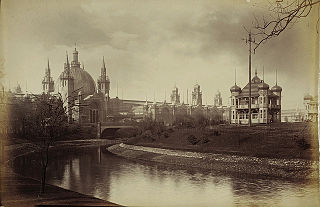
Edinburgh is the capital city of Scotland and one of its 32 council areas. The city was historically part of the county of Midlothian, but was administered separately from the surrounding county from 1482 onwards. It is located in Lothian on the southern shore of the Firth of Forth. Edinburgh is Scotland's second-most populous city, after Glasgow, and the seventh-most populous city in the United Kingdom.

Glasgow is the most populous city in Scotland and the fourth-most populous city in the United Kingdom, as well as being the 27th largest city by population in Europe. In 2020, it had an estimated population of 635,640. The city was made a county of itself in 1893, prior to which it had been in the historic county of Lanarkshire. The city now forms the Glasgow City Council area, one of the 32 council areas of Scotland, and is governed by Glasgow City Council. It is situated on the River Clyde in the country's West Central Lowlands.

1890–91 in Scottish football was the 18th season of competitive football in Scotland. This season saw the introduction of the Scottish Football League with ten teams competing.

Inverleith is an inner suburb in the north of Edinburgh, Scotland, on the fringes of the central region of the city. Its neighbours include Trinity to the north and the New Town to the south, with Canonmills at the south-east and Stockbridge at the south-west.

Edinburgh Science, founded in 1989, is an educational charity that aims to inspire people of all ages and backgrounds to discover the world around them. Edinburgh Science is best known for organising Edinburgh's annual Science Festival the world's first public celebration of science and technology and still one of Europe's largest. The two-week Festival gives audiences amazing experiences through a diverse programme of innovative events. Alongside the annual Festival in Edinburgh, the organisation has a strong focus on education and runs touring programme Generation Science that visits schools around Scotland throughout the year. Edinburgh Science also operates a large-scale international programme of work under the Worldwide arm. It regularly presents events overseas and has been the Major Programming Partner of the annual Abu Dhabi Science Festival, helping to curate, produce and deliver the event.

The Glasgow Garden Festival was the third of the five national garden festivals, and the only one to take place in Scotland.

Empire Exhibition, Scotland 1938 was an international exposition held at Bellahouston Park in Glasgow, from May to December 1938.

The Meadows is a large public park in Edinburgh, Scotland, to the south of the city centre.
Shandon is an area of Edinburgh within North Merchiston approximately three miles west of the centre of Edinburgh. It is bounded by Slateford Road to the north, Harrison Road to the east, the Union Canal to the south and the Glasgow-Edinburgh Shotts Line and Suburban rail lines to the west.

The International Exhibition of Science, Art and Industry was the first of 4 international exhibitions held in Glasgow, Scotland during the late 19th and early 20th centuries. It took place at Kelvingrove Park between May and November 1888. The main aim of the exhibition was to draw international attention to the city's achievements in applied sciences, industry and the arts during the Industrial Revolution. However, it was also hoped the Exhibition would raise enough money for a much-needed museum, art gallery and school of art in the city. The exhibition was opened by the Prince of Wales, as honorary president of the exhibition, on 8 May 1888. It was the greatest exhibition held outside London and the largest ever in Scotland during the 19th century.

The Glasgow International Exhibition was the second of 4 international exhibitions held in Glasgow, Scotland during the late 19th and early 20th centuries. The exhibition took place during a period of half-mourning requested by Edward VII but was still popular and made more than £35000 profit. The exhibition was opened by the King's daughter, the Princess Louise, Duchess of Fife.

The Scottish Exhibition of National History, Art and Industry was held in Glasgow in 1911. It was the third of 4 international exhibitions held in Glasgow, Scotland during the late 19th and early 20th centuries.

Sir James Gowans was an Edinburgh architect and builder.
Events from the year 1911 in Scotland.
Events from the year 1890 in Scotland.
Events from the year 1888 in Scotland.

The International Exhibition of Industry, Science and Art was a World's fair held in Edinburgh, Scotland in 1886.
The Edinburgh Exhibition Cup was an invitational football tournament held at the Exhibition Sports Grounds, Saughton, Edinburgh in August 1908, as part of the Scottish National Exhibition event being held there during that summer.













